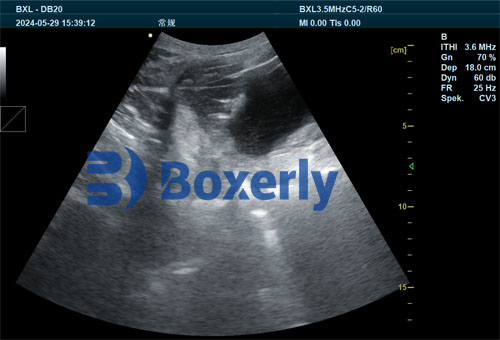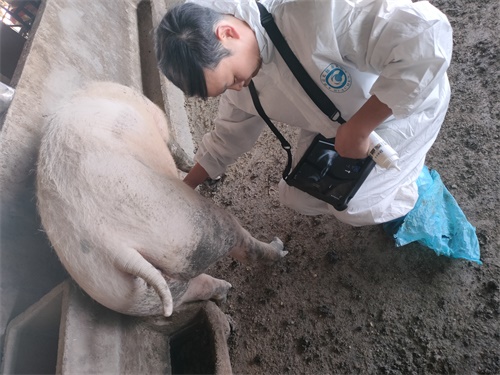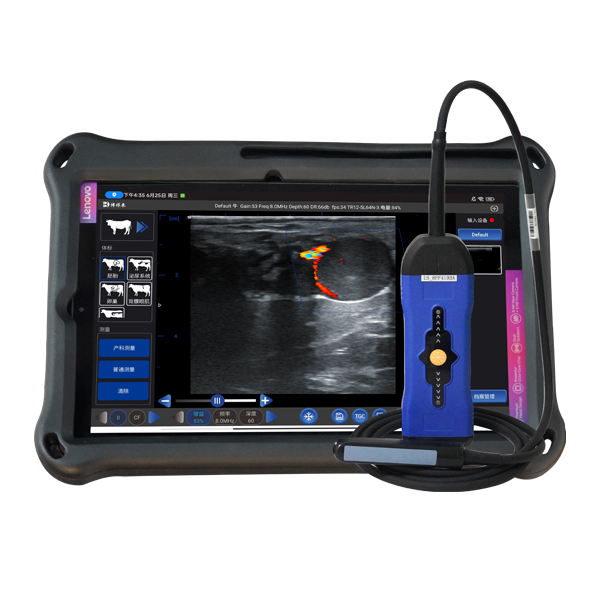For swine producers around the world, managing reproductive efficiency is one of the most vital aspects of successful pig farming. Knowing whether a sow is pregnant, and understanding the progression of that pregnancy, directly impacts farrowing rates, feed management, herd health, and overall profitability. One of the most reliable and non-invasive tools available for pregnancy detection and monitoring is B-mode ultrasonography.

This imaging technology, also known simply as real-time ultrasound, has become a routine part of veterinary reproductive management in commercial pig farms, particularly in North America and Europe. In this article, we will explore how B-mode ultrasound is used to study pregnancy in swine, what benefits it brings to modern pig farming, and how farmers and veterinarians around the world apply this technique to improve breeding efficiency and animal welfare.
Understanding Swine Pregnancy Detection: The Basics
Pregnancy in sows typically lasts around 114 days (approximately 3 months, 3 weeks, and 3 days). During this period, proper monitoring ensures that only pregnant sows remain in the gestation area and receive proper care. Non-pregnant sows, on the other hand, can be re-bred promptly, minimizing economic loss due to extended non-productive days.
Traditionally, methods like observing behavioral signs, palpation, or even hormonal testing were used, but each had limitations. B-mode ultrasound offers a visual confirmation of fetal structures, uterine fluid, and later, fetal movement—making it a preferred option in many countries.
In the United States, Canada, and much of Europe, routine ultrasound exams are performed around 21–35 days post-insemination, a window where fetal fluid and embryonic vesicles can be easily identified. By this point, the implantation process is complete, and the likelihood of detecting viable embryos is high.

The Science Behind B-Mode Ultrasound in Pigs
B-mode ultrasound generates two-dimensional grayscale images in real time. When the probe is placed on the sow’s abdomen or inserted transabdominally in the inguinal region, it emits high-frequency sound waves into the body. These waves reflect off tissues of differing densities—such as the uterus, amniotic fluid, and fetuses—and return to the probe, where they are processed into visual images.
Because it is safe, quick, and repeatable, B-mode ultrasound is ideal for use in a variety of environments—from large commercial farms in Denmark to small family operations in Latin America.
Key structures that can be seen during pregnancy include:
Anechoic (black) fluid areas within the uterus, representing amniotic fluid
Hyperechoic (white) dots or lines representing fetal bones
Movement of the fetus as pregnancy progresses
In practice, multiple sows can be examined per hour, and false negatives are rare when performed correctly during the optimal detection window.
International Best Practices: How Different Countries Use Ultrasound
In Denmark and the Netherlands, where pig production is among the most technologically advanced, routine B-mode ultrasound exams are conducted by trained technicians as early as 21 days post-insemination. These countries use standard scanning protocols and record the data digitally to track breeding performance.
In North America, producers also rely heavily on ultrasound but often integrate the results into broader herd management software, allowing them to correlate pregnancy rates with feeding data, weaning performance, and sow parity history.
In emerging swine industries like Brazil and Vietnam, the use of B-mode ultrasound is growing rapidly, thanks to increased training availability and more affordable portable machines. It allows producers to limit the number of non-productive animals, reduce feed waste, and improve reproductive outcomes.
Veterinarians in the UK and Australia emphasize the importance of regular training and probe maintenance, ensuring optimal image quality and interpretation accuracy.

Timing and Frequency of Pregnancy Scans
The recommended schedule for using B-mode ultrasound in pregnancy detection includes:
Early Pregnancy Scan (Day 21–35)
To confirm pregnancy and identify early embryonic loss.Mid-Gestation Scan (Day 40–60)
To assess fetal development, count embryos (if needed), and detect mummified or non-viable fetuses.Late-Gestation Scan (Day 80–100)
Less common, but useful for monitoring high-risk pregnancies or suspected uterine infections.
Some farms scan only once, while others—particularly in research or high-efficiency production systems—may perform two or more scans to optimize management strategies.
Benefits of B-Mode Ultrasound in Swine Reproduction
1. Accurate and Early Pregnancy Detection
Compared to waiting for external signs of pregnancy (which can be misleading), ultrasound provides definitive confirmation. This means that open sows can be quickly identified and re-bred, increasing overall farrowing rates.
2. Reduced Non-Productive Days
By identifying non-pregnant sows early, farmers avoid spending money on feed, space, and labor for animals not contributing to productivity.
3. Improved Animal Welfare
Non-invasive and stress-free, B-mode ultrasound causes minimal discomfort. Proper pregnancy detection ensures appropriate nutritional and veterinary care tailored to pregnant animals.
4. Enhanced Decision-Making
Ultrasound findings can be integrated with other farm data—such as sow age, body condition, and historical fertility—to inform culling decisions or to manage high-risk pregnancies.
5. Monitoring Reproductive Health
Beyond just confirming pregnancy, ultrasound can detect uterine abnormalities like cysts, fluid buildup, or mummified fetuses, allowing for earlier intervention.
Challenges and Limitations
Despite its many benefits, B-mode ultrasound also presents some challenges:
Operator Dependence: Image interpretation requires skill and experience. Misreading can lead to false positives or negatives.
Equipment Cost: While portable machines like the BXL-V50 are becoming more affordable, initial investment is still a barrier for small farms.
Timing Sensitivity: Scanning too early can miss developing embryos; scanning too late may miss early embryonic loss.
Animal Factors: Overweight sows or sows with full intestines may produce unclear images.
To mitigate these issues, many producers invest in training and use machines with high-resolution imaging and wide scanning angles.
The Role of Portable Ultrasound Devices
In recent years, portable, ruggedized B-mode ultrasound scanners—like the BXL-V50—have made on-farm pregnancy detection more accessible. Designed specifically for livestock, the BXL-V50 features:
An 8-inch HD screen for clear imaging
Waterproof design suitable for farm environments
Long battery life (7+ hours)
Easy probe maneuverability for rapid exams
USB image storage for record keeping
Such machines are favored by both independent veterinarians and commercial pig producers, especially in remote or high-volume settings.

The Future of Swine Pregnancy Monitoring
Looking ahead, B-mode ultrasound is expected to become even more integrated into reproductive management systems. Some trends already emerging include:
Automated scanning systems for large herds
AI-powered image interpretation to reduce operator error
Cloud-connected devices that link scan data with farm management software
3D and Doppler upgrades for enhanced diagnostic capabilities
In addition, increased use in developing countries may help reduce global food insecurity by improving the reproductive efficiency of local swine herds.
Conclusion
B-mode ultrasound is a game-changer for modern pig production. From early pregnancy detection to monitoring fetal development, this non-invasive tool empowers farmers and veterinarians to make smarter decisions that enhance herd productivity, reduce waste, and improve animal welfare.
As the technology becomes more affordable and user-friendly, we can expect broader adoption worldwide. For any producer serious about efficient and sustainable swine farming, integrating B-mode ultrasound into daily management is not just beneficial—it’s essential.
Reference Sources:
Knox, R. V. (2020). Advances in swine reproduction: Technologies and trends in ultrasound use. Journal of Animal Science, 98(2). https://doi.org/10.1093/jas/skz361
European Food Safety Authority (EFSA). (2019). Pig welfare and reproductive health. https://www.efsa.europa.eu/en/news
National Pork Board. (2022). Swine ultrasound application guide. https://www.pork.org
USDA Swine Research Program. (2023). Pregnancy detection in sows using real-time ultrasound. https://www.ars.usda.gov
Chison Veterinary Imaging. (2024). portable ultrasound Solutions for Farm Animals. https://www.bxlvet.com
link: https://www.bxlimage.com/nw/1255.html
tags:







